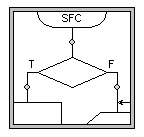
| Download current version of SFC | |
| Version 2.3 | SFC - Window's '95, '98, and NT version |
| SFC - User's Manual (PDF Document) |
Program development can be described as a seven step process:
Planning the logic of the program requires the development of algorithms. An algorithm is a finite, ordered set of unambiguous steps that terminates with a solution to the problem. Human readable representations such as flow charts and pseudo code are typically used to describe the steps of an algorithm and the relationships among the steps.
A flow chart is a graphical representation of the steps and control structures used in an algorithm. A flow chart does not involve a particular programming language, but rather uses a set of geometric symbols and flow control lines to describe the algorithm. From a flowchart, a programmer can produce the high level code required to compile an executable program.
Initially, the standard for describing flow charts only specified the types of shapes and lines used to produce a flow chart. The introduction of structured programming in the 1960ís and 70ís brought with it the concept of Structured Flow Charts. In addition to a standard set of symbols, structured flow charts specify conventions for linking the symbols together into a complete flow chart.
The structured programming paradigm evolved from the mathematically proven concept that all problems can be solved using only three types of control structures:
The definition of structured flow charts used in this document and software further defines:
The SFC program is designed to aid the programmer in designing and presenting structured flow charts.
Software and Documentation Copyright Ó Tia Watts 2001